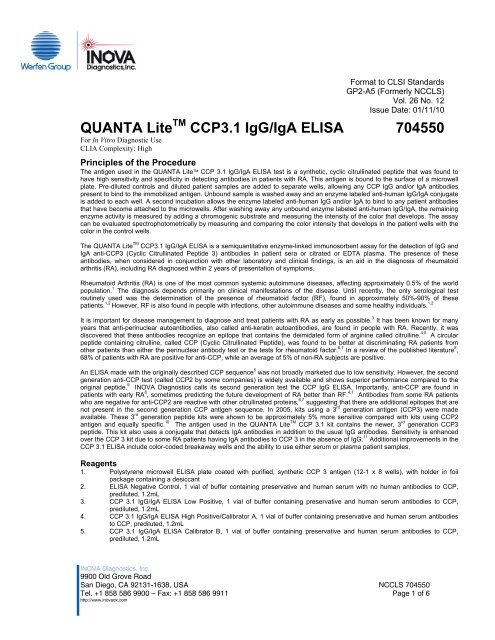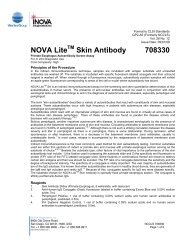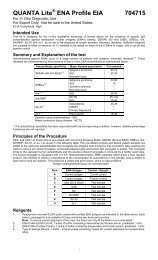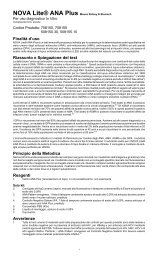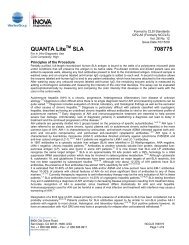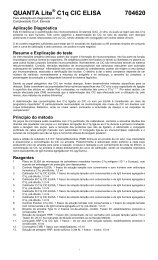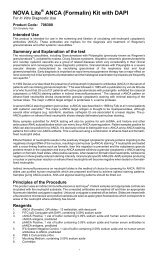QUANTA Lite CCP3.1 IgG/IgA ELISA 704550 - inova
QUANTA Lite CCP3.1 IgG/IgA ELISA 704550 - inova
QUANTA Lite CCP3.1 IgG/IgA ELISA 704550 - inova
- No tags were found...
You also want an ePaper? Increase the reach of your titles
YUMPU automatically turns print PDFs into web optimized ePapers that Google loves.
Format to CLSI StandardsGP2-A5 (Formerly NCCLS)Vol. 26 No. 12Issue Date: 01/11/10<strong>QUANTA</strong> <strong>Lite</strong> TM <strong>CCP3.1</strong> <strong>IgG</strong>/<strong>IgA</strong> <strong>ELISA</strong> <strong>704550</strong>For In Vitro Diagnostic UseCLIA Complexity: HighPrinciples of the ProcedureThe antigen used in the <strong>QUANTA</strong> <strong>Lite</strong> CCP 3.1 <strong>IgG</strong>/<strong>IgA</strong> <strong>ELISA</strong> test is a synthetic, cyclic citrullinated peptide that was found tohave high sensitivity and specificity in detecting antibodies in patients with RA. This antigen is bound to the surface of a microwellplate. Pre-diluted controls and diluted patient samples are added to separate wells, allowing any CCP <strong>IgG</strong> and/or <strong>IgA</strong> antibodiespresent to bind to the immobilized antigen. Unbound sample is washed away and an enzyme labeled anti-human <strong>IgG</strong>/<strong>IgA</strong> conjugateis added to each well. A second incubation allows the enzyme labeled anti-human <strong>IgG</strong> and/or <strong>IgA</strong> to bind to any patient antibodiesthat have become attached to the microwells. After washing away any unbound enzyme labeled anti-human <strong>IgG</strong>/<strong>IgA</strong>, the remainingenzyme activity is measured by adding a chromogenic substrate and measuring the intensity of the color that develops. The assaycan be evaluated spectrophotometrically by measuring and comparing the color intensity that develops in the patient wells with thecolor in the control wells.The <strong>QUANTA</strong> <strong>Lite</strong> TM <strong>CCP3.1</strong> <strong>IgG</strong>/<strong>IgA</strong> <strong>ELISA</strong> is a semiquantitative enzyme-linked immunosorbent assay for the detection of <strong>IgG</strong> and<strong>IgA</strong> anti-CCP3 (Cyclic Citrullinated Peptide 3) antibodies in patient sera or citrated or EDTA plasma. The presence of theseantibodies, when considered in conjunction with other laboratory and clinical findings, is an aid in the diagnosis of rheumatoidarthritis (RA), including RA diagnosed within 2 years of presentation of symptoms.Rheumatoid Arthritis (RA) is one of the most common systemic autoimmune diseases, affecting approximately 0.5% of the worldpopulation. 1The diagnosis depends primarily on clinical manifestations of the disease. Until recently, the only serological testroutinely used was the determination of the presence of rheumatoid factor (RF), found in approximately 50%-90% of thesepatients. 1,2 However, RF is also found in people with infections, other autoimmune diseases and some healthy individuals. 1,2It is important for disease management to diagnose and treat patients with RA as early as possible. 3 It has been known for manyyears that anti-perinuclear autoantibodies, also called anti-keratin autoantibodies, are found in people with RA. Recently, it wasdiscovered that these antibodies recognize an epitope that contains the deimidated form of arginine called citrulline. 4,5A circularpeptide containing citrulline, called CCP (Cyclic Citrullinated Peptide), was found to be better at discriminating RA patients fromother patients than either the perinuclear antibody test or the tests for rheumatoid factor. 6,7 In a review of the published literature 8 ,68% of patients with RA are positive for anti-CCP, while an average of 5% of non-RA subjects are positive.An <strong>ELISA</strong> made with the originally described CCP sequence 5 was not broadly marketed due to low sensitivity. However, the secondgeneration anti-CCP test (called CCP2 by some companies) is widely available and shows superior performance compared to theoriginal peptide. 9INOVA Diagnostics calls its second generation test the CCP <strong>IgG</strong> <strong>ELISA</strong>. Importantly, anti-CCP are found inpatients with early RA 8 , sometimes predicting the future development of RA better than RF. 4,7Antibodies from some RA patientswho are negative for anti-CCP2 are reactive with other citrullinated proteins, 6,7 suggesting that there are additional epitopes that arenot present in the second generation CCP antigen sequence. In 2005, kits using a 3 rd generation antigen (CCP3) were madeavailable. These 3 rd generation peptide kits were shown to be approximately 5% more sensitive compared with kits using CCP2antigen and equally specific. 10The antigen used in the <strong>QUANTA</strong> <strong>Lite</strong> TM CCP 3.1 kit contains the newer, 3 rd generation CCP3peptide. This kit also uses a conjugate that detects <strong>IgA</strong> antibodies in addition to the usual <strong>IgG</strong> antibodies. Sensitivity is enhancedover the CCP 3 kit due to some RA patients having <strong>IgA</strong> antibodies to CCP 3 in the absence of <strong>IgG</strong>. 11 Additional improvements in theCCP 3.1 <strong>ELISA</strong> include color-coded breakaway wells and the ability to use either serum or plasma patient samples.Reagents1. Polystyrene microwell <strong>ELISA</strong> plate coated with purified, synthetic CCP 3 antigen (12-1 x 8 wells), with holder in foilpackage containing a desiccant2. <strong>ELISA</strong> Negative Control, 1 vial of buffer containing preservative and human serum with no human antibodies to CCP,prediluted, 1.2mL3. CCP 3.1 <strong>IgG</strong>/<strong>IgA</strong> <strong>ELISA</strong> Low Positive, 1 vial of buffer containing preservative and human serum antibodies to CCP,prediluted, 1.2mL4. CCP 3.1 <strong>IgG</strong>/<strong>IgA</strong> <strong>ELISA</strong> High Positive/Calibrator A, 1 vial of buffer containing preservative and human serum antibodiesto CCP, prediluted, 1.2mL5. CCP 3.1 <strong>IgG</strong>/<strong>IgA</strong> <strong>ELISA</strong> Calibrator B, 1 vial of buffer containing preservative and human serum antibodies to CCP,prediluted, 1.2mLINOVA Diagnostics, Inc.9900 Old Grove RoadSan Diego, CA 92131-1638, USA NCCLS <strong>704550</strong>Tel. +1 858 586 9900 – Fax: +1 858 586 9911 Page 1 of 6http://www.<strong>inova</strong>dx.com
6. CCP 3.1 <strong>IgG</strong>/<strong>IgA</strong> <strong>ELISA</strong> Calibrator C, 1 vial of buffer containing preservative and human serum antibodies to CCP,prediluted, 1.2mL7. CCP 3.1 <strong>IgG</strong>/<strong>IgA</strong> <strong>ELISA</strong> Calibrator D, 1 vial of buffer containing preservative and human serum antibodies to CCP,prediluted, 1.2mL8. CCP 3.1 <strong>IgG</strong>/<strong>IgA</strong> <strong>ELISA</strong> Calibrator E, 1 vial of buffer containing preservative and human serum antibodies to CCP,prediluted, 1.2mL9. HRP Sample Diluent, 1 vial – colored pink containing Tris-buffered saline, Tween 20, protein stabilizers and preservative,50mL10. High Specificity Wash Concentrate, 1 vial of 10x concentrate - colored red containing Tris-buffered saline and Tween 20,100mL. Refer to the Methods Section for dilution instructions.11. HRP CCP 3.1 <strong>IgG</strong>/<strong>IgA</strong> Conjugate, (goat), anti-human <strong>IgG</strong>/<strong>IgA</strong>, 1 vial – colored light yellow containing buffer, proteinstabilizers and preservative, 10mL12. TMB Chromogen, 1 vial containing stabilizers, 10mL13. HRP Stop Solution, 0.344M Sulfuric Acid, 1 vial – colorless, 10mLMaterials provided1 CCP 3.1 <strong>IgG</strong>/<strong>IgA</strong> <strong>ELISA</strong> microwell plate (12-1 x 8 wells), with holder1 1.2mL prediluted <strong>ELISA</strong> Negative Control1 1.2mL prediluted CCP 3.1 <strong>IgG</strong>/<strong>IgA</strong> <strong>ELISA</strong> Low Positive1 1.2mL prediluted CCP 3.1 <strong>IgG</strong>/<strong>IgA</strong> <strong>ELISA</strong> High Positive/Calibrator A1 1.2mL prediluted CCP 3.1 <strong>IgG</strong>/<strong>IgA</strong> <strong>ELISA</strong> Calibrator B1 1.2mL prediluted CCP 3.1 <strong>IgG</strong>/<strong>IgA</strong> <strong>ELISA</strong> Calibrator C1 1.2mL prediluted CCP 3.1 <strong>IgG</strong>/<strong>IgA</strong> <strong>ELISA</strong> Calibrator D1 1.2mL prediluted CCP 3.1 <strong>IgG</strong>/<strong>IgA</strong> <strong>ELISA</strong> Calibrator E1 50mL HRP Sample Diluent1 100mL High Specificity Wash Concentrate, 10x concentrate1 10mL HRP CCP 3.1 <strong>IgG</strong>/<strong>IgA</strong> Conjugate, (goat), anti-human <strong>IgG</strong>/<strong>IgA</strong>1 10mL TMB Chromogen1 10mL HRP Stop Solution, 0.344M Sulfuric AcidAdditional Materials Required But Not ProvidedMicropipets to deliver 5, 100, 200-300 and 500µLDisposable micropipet tipsTest tubes for patient sample dilutions, 4mL volumeDistilled or deionized water1L container for diluted High Specificity Wash ConcentrateMicrowell plate reader capable of measuring OD at 450nm (and 620nm for dual wavelength readings)SpecimenThis procedure should be performed with either a serum specimen or citrated plasma or EDTA plasma specimen, since thesesamples yielded identical results. Lithium and heparin plasma should not be used because they may yield results different thanserum. Addition of azide or other preservatives to the test samples may adversely affect the results. Microbially contaminated, heattreated,or specimens containing visible particulate should not be used. Grossly hemolyzed or lipemic serum or specimens shouldbe avoided.Following collection, the serum should be separated from the clot or the plasma should be stored as described below. NCCLSDocument H18-A3 recommends the following storage conditions for samples: 1) Store samples at room temperature no longer than8 hours. 2) If the assay will not be completed within 8 hours, refrigerate the sample at 2-8°C. 3) If the assay will not be completedwithin 48 hrs, or for shipment of the sample, freeze at -20°C or lower. Frozen specimens must be mixed well after thawing and priorto testing.Special Safety Precautions/Storage Conditions1. Store all the kit reagents at 2-8°C. Do not freeze. Reagents are stable until the expiration date when stored and handledas directed.2. Unused antigen coated microwell strips should be resealed securely in the foil pouch containing desiccants and stored at2-8°C.3. Diluted wash buffer is stable for 1 week at 2-8°C.Procedural Notes:Warnings1. WARNING: This product contains a chemical (0.02% chloramphenicol) in the sample diluent, controls, and conjugateknown to the State of California to cause cancer.2. All human source material used in the preparation of controls for this product has been tested and found negative forantibody to HIV, HBsAg, and HCV by FDA cleared methods. No test method however can offer complete assurance thatHIV, HBV, HCV or other infectious agents are absent. Therefore, the CCP 3.1 <strong>IgG</strong>/<strong>IgA</strong> <strong>ELISA</strong> Low Positive, CCP 3.1<strong>IgG</strong>/<strong>IgA</strong> <strong>ELISA</strong> High Positive/Calibrators and <strong>ELISA</strong> Negative Control should be handled in the same manner aspotentially infectious material. 12NCCLS <strong>704550</strong>Page 2 of 6
3. Sodium Azide is used as a preservative. Sodium Azide is a poison and may be toxic if ingested or absorbed through theskin or eyes. Sodium azide may react with lead or copper plumbing to form potentially explosive metal azides. Flushsinks, if used for reagent disposal, with large volumes of water to prevent azide build-up.4. The HRP conjugate contains a dilute poisonous/corrosive chemical, which may be toxic if ingested in large amounts. Toprevent possible chemical burns, avoid contact with skin and eyes.5. TMB Chromogen contains an irritant, which may be harmful if inhaled, ingested or absorbed through the skin. To preventinjury, avoid inhalation, ingestion or contact with skin and eyes.6. The HRP Stop Solution consists of a dilute sulfuric acid solution. Avoid exposure to bases, metals, or other compounds,which may react with acids. Sulfuric acid is a poison and corrosive, which may be toxic if ingested. To prevent chemicalburns, avoid contact with skin and eyes.7. Use appropriate personal protective equipment while working with the reagents provided.8. Spilled reagents should be cleaned up immediately. Observe all federal, state and local environmental regulations whendisposing of wastes.Precautions1. This product is for In Vitro Diagnostic Use.2. Substitution of components other than those provided in this system may lead to inconsistent results.3. Incomplete or inefficient washing and insufficient liquid removal from the <strong>ELISA</strong> well strips will cause poor precisionand/or high background.4. Adaptation of this assay for use with automated sample processors and other liquid handling devices, in whole or in part,may yield differences in test results from those obtained using the manual procedure. It is the responsibility of eachlaboratory to validate that their automated procedure yields test results within acceptable limits.5. A variety of factors influence the assay performance. These include the starting temperature of the reagents, the ambienttemperature, the accuracy and reproducibility of the pipetting technique, the thoroughness of washing and liquid removalfrom the wells of the <strong>ELISA</strong> strips, the photometer used to measure the results, and the length of the incubation timesduring the assay. Careful attention to consistency is required to obtain accurate and reproducible results.6. Strict adherence to the protocol is recommended.7. Incomplete resealing of the zip-lock pouch containing microwell strips and desiccant will result in antigen degradation andpoor precision.8. Unacceptably low absorbencies may be observed following two or more uses from a single bottle of HRP conjugate overa period of time. It is important to follow all recommended HRP conjugate handling procedures to prevent this occurrence.9. Chemical contamination of the HRP conjugate can result from improper cleaning or rinsing of equipment or instruments.Residues from common laboratory chemicals such as formalin, bleach, ethanol or detergent will cause degradation of theHRP conjugate over time. Thoroughly rinse all equipment or instruments after the use of chemical cleaners/disinfectants.Quality Control1. The CCP 3.1 <strong>IgG</strong>/<strong>IgA</strong> <strong>ELISA</strong> Low Positive, the CCP 3.1 <strong>IgG</strong>/<strong>IgA</strong> <strong>ELISA</strong> High Positive and the <strong>ELISA</strong> Negative Controlshould be run with every batch of samples to ensure that all reagents and procedures perform properly.2. Note that since the CCP 3.1 <strong>IgG</strong>/<strong>IgA</strong> <strong>ELISA</strong> Low Positive, the CCP 3.1 <strong>IgG</strong>/<strong>IgA</strong> <strong>ELISA</strong> High Positive and the <strong>ELISA</strong>Negative Control are prediluted, they do not control for procedural methods associated with dilution of specimens.3. Additional controls may be tested according to guidelines or requirements of local, state and/or federal regulations oraccrediting organizations. Additional suitable control sera may be prepared by aliquoting pooled human serum specimensand storing at < -20°C.4. In order for the test results to be considered valid, all of the criteria listed below must be met. If any of these are not met,the test should be considered invalid and the assay repeated.a. The absorbance of the prediluted CCP 3.1 <strong>IgG</strong>/<strong>IgA</strong> <strong>ELISA</strong> High Positive must be greater than the absorbanceof the prediluted CCP 3.1 <strong>IgG</strong>/<strong>IgA</strong> <strong>ELISA</strong> Low Positive, which must be greater than the absorbance of theprediluted <strong>ELISA</strong> Negative Control.b. The prediluted CCP 3.1 <strong>IgG</strong>/<strong>IgA</strong> <strong>ELISA</strong> High Positive must have an OD greater than 1.0 while the prediluted<strong>ELISA</strong> Negative Control absorbance cannot be over 0.2.c. The CCP 3.1 <strong>IgG</strong>/<strong>IgA</strong> <strong>ELISA</strong> Low Positive absorbance must be more than twice the <strong>ELISA</strong> Negative Control orover 0.25.d. The <strong>ELISA</strong> Negative Control and CCP 3.1 <strong>IgG</strong>/<strong>IgA</strong> <strong>ELISA</strong> High Positive are intended to monitor for substantialreagent failure. The CCP 3.1 <strong>IgG</strong>/<strong>IgA</strong> <strong>ELISA</strong> High Positive will not ensure precision at the assay cutoff.e. The user should refer to CLSI (NCCLS) Document C24-A3 for additional guidance on appropriate QC practices.Procedure:Method Before you start1. Bring all reagents and samples to room temperature (20-26 o C) and mix well.2. Dilute the High Specificity Wash Concentrate 1:10 by adding the contents of the High Specificity Wash Concentrate bottleto 900mL of distilled or deionized water. If the entire plate will not be run within this period, a smaller quantity can beprepared by adding 10.0mL of the concentrate to 90mL of distilled or deionized water for every 16 wells that will be used.The diluted buffer is stable for 1 week at 2-8 o C.3. Prepare a 1:101 dilution of each patient sample by adding 5µL of sample to 500µL of HRP Sample Diluent. Dilutedsamples must be used within 8 hours of preparation. DO NOT DILUTE the CCP 3.1 <strong>IgG</strong>/<strong>IgA</strong> <strong>ELISA</strong> Low Positive, <strong>CCP3.1</strong> <strong>IgG</strong>/<strong>IgA</strong> <strong>ELISA</strong> High Positive and <strong>ELISA</strong> Negative Control.4. Determination of the presence or absence of anti-CCP 3.1 antibodies using arbitrary units requires two wells for each ofthe three controls and one or two wells for each patient sample. It is recommended that samples be run in duplicate.NCCLS <strong>704550</strong>Page 3 of 6
5. If desired, results can be quantitated by using a 5-point standard curve. For points A through E of the 5-point standardcurve, use PREDILUTED CCP 3.1 Calibrators A through E directly from the vial. The five point standard curve has thefollowing values:PointUnitsA Prediluted CCP 3.1 <strong>IgG</strong>/<strong>IgA</strong> Calibrator A 250.0B Prediluted CCP 3.1 <strong>IgG</strong>/<strong>IgA</strong> Calibrator B 125.0C Prediluted CCP 3.1 <strong>IgG</strong>/<strong>IgA</strong> Calibrator C 62.5D Prediluted CCP 3.1 <strong>IgG</strong>/<strong>IgA</strong> Calibrator D 31.25E Prediluted CCP 3.1 <strong>IgG</strong>/<strong>IgA</strong> Calibrator E 15.62Assay Procedure1. ALL REAGENTS MUST BE BROUGHT TO ROOM TEMPERATURE (20-26°C) PRIOR TO BEGINNING THE ASSAY.Place the required number of microwells/strips in the holder. Immediately return unused strips to the pouchcontaining desiccants and seal securely to minimize exposure to water vapor.2. Add 100µL of the prediluted CCP 3.1 <strong>IgG</strong>/<strong>IgA</strong> <strong>ELISA</strong> Low Positive, the CCP 3.1 <strong>IgG</strong>/<strong>IgA</strong> <strong>ELISA</strong> High Positive, CalibratorsB through E if desired, the <strong>ELISA</strong> Negative Control and the diluted patient samples to the wells. Cover the wells andincubate for 30 minutes at room temperature on a level surface. The incubation time begins after the last sample addition.3. Wash step: Thoroughly aspirate the contents of each well. Add 200-300µL of the diluted HRP Wash buffer to all wells,then aspirate. Repeat this sequence twice more for a total of three washes. Invert the plate and tap it on absorbentmaterial to remove any residual fluid after the last wash. It is important to completely empty each well after each washingstep. Maintain the same sequence for the aspiration as was used for the sample addition.4. Add 100μL of the HRP CCP 3.1 <strong>IgG</strong>/<strong>IgA</strong> Conjugate to each well. Conjugate should be removed from the bottles usingstandard aseptic conditions and good laboratory techniques. Remove only the amount of conjugate from the bottlenecessary for the assay. TO AVOID POTENTIAL MICROBIAL AND/OR CHEMICAL CONTAMINATION, NEVERRETURN UNUSED CONJUGATE TO THE BOTTLE. Incubate the wells for 30 minutes as in step 2.5. Wash step: Repeat step 3.6. Add 100µL of TMB Chromogen to each well and incubate in the dark for 30 minutes at room temperature.7. Add 100µL of HRP Stop Solution to each well. Maintain the same sequence and timing of HRP Stop Solution addition aswas used for the TMB Chromogen. Gently tap the plate with a finger to thoroughly mix the wells.8. Read the absorbance (OD) of each well at 450nm within one hour of stopping the reaction. If bichromatic measurementsare desired, 620nm can be used as a reference wavelength.Reporting Results:Interpretation of ResultsThe <strong>ELISA</strong> assay is very sensitive to technique and is capable of detecting even small differences in patient populations. The valuesshown below are suggested values only. Each laboratory should establish its own normal range based upon its own techniques,controls, equipment and patient population according to their own established procedures.The sample can then be classified as negative, weak positive, moderate positive or strong positive according to the table below.UnitsNegative
Optional Method of Calculation: Semi-Quantitative Results using a Standard CurveCalculation of results with the optional standard curve1. Determine a mean value for all duplicate readings.2. Plot the mean absorbance (OD) of the samples in the standard curve against their values in Units. Use a linear/linearCubic Spline (third order polynomial) or a point-to-point line fit to draw the curve.3. Determine the unknown anti-CCP 3.1 concentration in Units from the “Y” axis by reading the corresponding absorbanceon the “X” axis. Calculate the unknown Units.4. Note: The values calculated with the ratio method will be different than those calculated by the standard curve. Highvalues will differ more than low values. The CCP 3.1 <strong>IgG</strong>/<strong>IgA</strong> High Positive will not yield a value of 250 Units with the ratiomethod.Expected Values from Clinical SamplesThe ability of the <strong>QUANTA</strong> <strong>Lite</strong> TM <strong>CCP3.1</strong> <strong>IgG</strong>/<strong>IgA</strong> <strong>ELISA</strong> to detect <strong>IgG</strong>/<strong>IgA</strong> CCP3 antibodies was evaluated by comparison of 942samples to an <strong>ELISA</strong> that measures <strong>IgG</strong> anti-CCP2. Included were 495 patients with a clinical diagnosis of RA from both internal(186) and external (309) studies. Sera from 275 random blood donors were also tested. Of the 272 where age and sex wereavailable, 97 were female and the average age was 42.4 years. Disease controls included 74 people with other rheumatic diseases(ORD) such as systemic lupus erythematosus (34), Sjögren’s Syndrome (16) and scleroderma (24), as well as an additional 98samples with antibodies to infectious diseases (ID) such as hepatitis C (58), herpes simplex virus (15), cytomegalovirus (14),toxoplasmosis (6) and rubella (5) in one large internal study.Relative Specificity/SensitivityClinical Sensitivity and SpecificityThe following table summarizes the findings of all our clinical studies.Samples N=942 <strong>CCP3.1</strong> <strong>ELISA</strong> CCP <strong>ELISA</strong>+ - + -RA (Total N=495) 348 147 320 175RA – within 2 years (N=86) 55 31 47 39Total Controls (N=447) 10 437 8 439Blood Donors (N=275) 2 273 3 272ORD (N=74) 6 68 4 70Infectious Disease (N=98) 2 96 1 97Clinical Sensitivity [95% Confidence Interval (CI)] = <strong>CCP3.1</strong> = 70.3% (66-74%)CCP = 64.6% (60-69%)In RA within 2 years = <strong>CCP3.1</strong> = 64.0% (52-74%)CCP = 54.7% (43-65%)Clinical Specificity (95% CI) = <strong>CCP3.1</strong> = 97.8% (96-99%)CCP = 98.2% (97-99%)Method ComparisonN=942<strong>CCP3.1</strong><strong>IgG</strong>/<strong>IgA</strong><strong>ELISA</strong>CCP <strong>IgG</strong> <strong>ELISA</strong> Total % Agreement (95% CI)Positive NegativePositive 320 38* 358 Pos. % Agree=97.6% (95.3-98.9%)Negative 8** 576 584 Neg. % Agree=93.8% (91.6-95.6%)Total 328 614 942 Tot. % Agree=95.1%*33 of these samples are diagnosed RA.**5 of these samples are diagnosed RA.Cross-ReactivityTo assess potential cross-reactivity of <strong>CCP3.1</strong> antigen with other autoantibodies, the <strong>QUANTA</strong> <strong>Lite</strong> <strong>CCP3.1</strong> <strong>ELISA</strong> was evaluatedwith 16 samples, all having high levels of various other autoantibodies. Included in this group were 2 samples each that reacted withSS-A, SS-B, Sm, RNP, Scl-70, Jo-1, Ribo-P and dsDNA. All samples were negative for anti-<strong>CCP3.1</strong>. The above study shows nosignificant cross-reactivity of the <strong>CCP3.1</strong> antigen with a variety of other autoantibodies.Precision and ReproducibilityThe between-run assay variation was measured by running duplicates of negative, low positive, and strong positive samples in 6separate assays on 5 different days. The within-run assay variation was measured by running 9 samples 9 or 10 times each on thesame <strong>ELISA</strong> plate. Representative results are shown below.NCCLS <strong>704550</strong>Page 5 of 6
Between-run VariationNegative 1 Low 1 Low 2 High 11 pt.* 5 pt.** 1 pt. 5 pt. 1 pt. 5 pt. 1 pt. 5 pt.Mean 6 U 4 U 22 U 23 U 28 U 30 U 69 U 85 USD 0.4 0.5 0.7 0.6 0.8 1.2 1.7 1.2CV% 8% 11% 3% 3% 3% 4% 2% 1%Within-Run VariationNegative 1 Low 1 Low 2 High 11 pt. 5 pt. 1 pt. 5 pt. 1 pt. 5 pt. 1 pt. 5 pt.Mean 4 U 2 U 22 U 24 U 26 U 30 U 68 U 81 USD 0.2 0.2 0.9 1.1 0.9 1.0 1.9 3.2CV% 4% 13% 4% 5% 3% 3% 3% 4%*Ratio method test results**Standard Curve test resultsLimitations of the Procedure1. The presence of immune complexes or other immunoglobulin aggregates in the patient sample may cause an increasedlevel of non-specific binding and produce false positives in this assay.2. Not all RA patients are positive for anti-CCP.3. Results of this assay should be used in conjunction with clinical findings and other serological tests.4. The assay performance characteristics have not been established for matrices other than serum, EDTA plasma andcitrated plasma.5. The diagnostic value of anti-CCP 3 in Juvenile Rheumatoid Arthritis patients has not been determined.6. Interfering substances: High levels of hemoglobin, bilirubin, cholesterol or triglycerides do not cause false negative orfalse positive results.References1. Wener MH: Rheumatoid Factors. Manual of Clinical Laboratory Immunology, NR Rose et al., eds, American Societyfor Microbiology Press, 961-972 (2002).2. Borretzen M et al.: Rheumatoid Factors. Autoantibodies, Peter JB and Shoenfeld Y, eds, Elsevier Science B.V., 706-715 (1996).3. Kim JK and Weisman MH: When does rheumatoid arthritis begin and why do we need to know? Arthritis Rheum 43:473-484 (2000).4. Vossenaar ER and Van Venrooj WJ: Anti-CCP antibodies, a highly specific marker for (early) rheumatoid arthritis.Clin Applied Immunol Rev 4: 239-262 (2004).5. Schellekens GA et al.: Citrulline is an essential constituent of antigenic determinants recognized by rheumatoidarthritis-specific autoantibodies. J Clin Invest. 101: 273-281 (1998).6. Vittecoq O et al.: Autoantibodies recognizing citrullinated rat filaggrin in an <strong>ELISA</strong> using citrullinated and noncitrullinatedrecombinant proteins as antigens are highly diagnostic for rheumatoid arthritis. Clin Exp Immunol 135:173-180 (2004).7. Saraux A et al.: Value of antibodies to citrulline-containing peptides for diagnosing early rheumatoid arthritis. JRheumatol 30: 2550-2539 (2003).8. Avovac J et al: Diagnostic and predictive value of anti-cycllic citrullinated protien antibodies in rheumatiod arthritis: asystematic literature review. Ann Rheum Dis 65: 845-851 (2006).9. van Gaalen FA et al.: A comparison of the diagnostic accuracy and prognostic value of the first- and second anti-cycliccitrullinated peptide autoantibody (CCP1 and CCP2) tests for rheumatoid arthritis. Ann Rheum Dis 64: 1510-1512(2005)10. Mittermayer S et al.: A comparison of the frequency of autoantibodies to cyclic citrullinated peptides using a thirdgeneration CCP assay (CCP3) in systemic sclerosis, primary biliary cirrhosis and rheumatoid arthritis. Clin RheumatolJune 15, e-pub ahead of print (2007).11. Vieira LEA et al: Rheumatoid arthritis diagnosis: a comparative study of second and third generation anti-cycliccitrullinated peptide (CCP) <strong>ELISA</strong>s. Arthritis Rheum 56: S724 (2007).12. Biosafety in Microbiological and Biomedical Laboratories. Centers for Disease Control/National Institutes of Health,Fifth Edition, 2007.INOVA Diagnostics, Inc. 888-545-74959900 Old Grove Road 624550 Rev. 2San Diego, CA 921312009/OCTNCCLS <strong>704550</strong>Page 6 of 6


